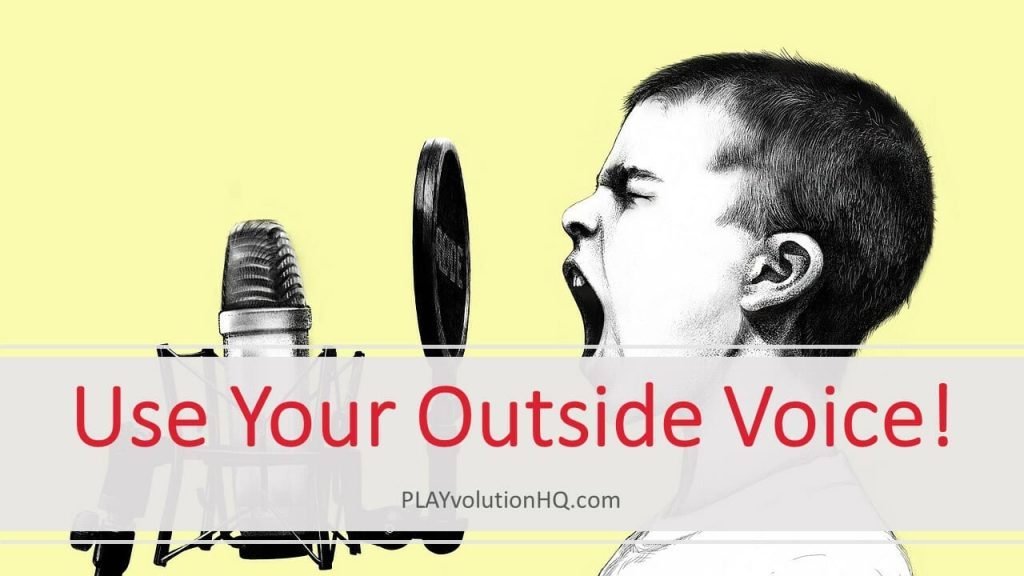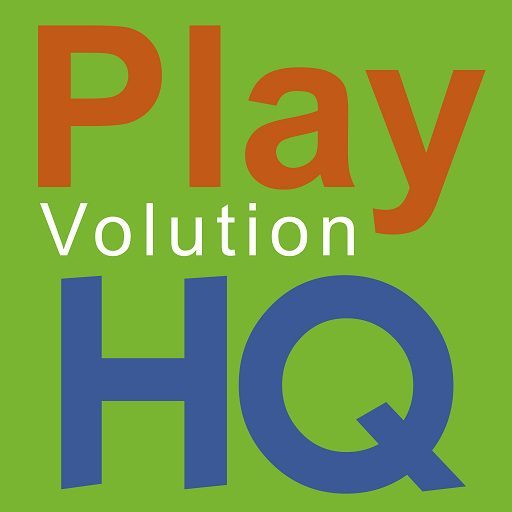
Think of the last time you heard an adult admonish a child to, “Use Your Outside Voice!”, or question, “Why’s it so quiet in here? How many times have I told you kids to be more noisy!”, or strain through clinched teeth, “You’ll be louder if you know what’s good for you!”, or shout from a park bench, “We’re not leaving this playground until I hear some screaming!”
It’s probably been a while.
Now think about how often you where hushed as a child.
From shortly after their first lung-filling post-uterine breath and primal welcome-to-the-world scream, we hush kids.
In many situations, we adults gravitate not only toward inside voices, but complete quiet. I remember being scolded (again) by Miss Lamb, my third-grade teacher, in a fearfully-stern (and loud) voice, “Jeffery! Be! Quiet! We’re studying English! Not! Talking!”
We treat voice volume as a moral issue instead of a developmental one. Quiet kids are seen as good, we’ll behaved, and polite. They are docile, manageable little lambs. In contrast, loud kids are looked at as unruly, ill mannered, and disrespectful. They are wild, chaotic crocodiles. In Miss Lambs eyes, I was a bad kid. (That’s not conjecture: she straight up told me as much every time she revoked a recess.)
Although I’m sure I was far from her ideal student, I wasn’t bad. I was an average eight-year-old child. I was a social creature that wanted to communicate. I had a voice that could yell as well as whisper. I struggled with all the silence expected of me. I don’t recall Miss Lamb, or any other adult in my life, ever urging me to use my outside voice.
And that’s a shame.

Only using your inside voice is like only using Red, Orange, and Yellow paint at the easel while Green, Blue, and Purple sit unopened in the storage room. Only using your inside voice is like playing Gershwin without the keys on the left side of the piano. Only using your inside voice is like only using your legs for walking.
Life is fuller when we paint with all the colors, play music with all the keys, use our legs to run, leap, and climb as well as walk, and have opportunity to playfully explore our voice’s full range.
I’m not arguing for all noise all the time. I’m arguing for balance. There are times for muted voices and even complete silence—and, there are times to get loud. As it stands, the Volume Knob in early learning settings tends to be set below 4 most of the time. I think we need to create more time and space to crank it to 10…maybe eleven. The human voice is a tool—if you’re going to have a tool, you should know all its capabilities and practice using it.
I can hear someone thinking, “Jeff, kids are loud enough. They don’t need us encouraging them to make noise.” I argue that in a world where children are constantly hushed, shushed, and scolded to be quiet by adults that maybe a few of them actually do need some encouragement—some overt permission.

Creating time and space for Loud has some benefits:
- Kids who get regular opportunities to play around with the full range of their voices may find it easier to self-regulate when inside voices are necessary.
- Permission to be loud may lead to more active whole-body play—more running, spinning, climbing, hauling, and throwing. Among other things, those activities build stronger cores, large and small muscle strength and control, and visual tracking skills. It could be argued that the rambunctious, ruckus, rollicking play that accompanies permission to be loud helps prepare kids to read and write.
- There’s an emotional release in being noisy that can help kids blow off steam. You may find that kids encouraged to make some noise now and again are calmer and more focused.
- Exposure to loud helps with sensory processing, sensory integration, and auditory discrimination. Brains and bodies that spend most of their time in quiet settings need opportunities to practice processing louder input.
Consider looking for opportunities to crank up the volume and give kids explicit permission to use their outside voices. Catch them being quiet one in a while and ask them to make some noise.
Author
Jeff Johnson is an early learning trainer, podcaster, and author who founded Explorations Early Learning, Playvolution HQ, and Play Haven.
In-Person And Online Training
Learn how to book an in-person or online training for your organization on these early learning topics.
Support The Site
I participate in the Amazon Services LLC Associates Program, an affiliate advertising program designed to provide a means for me to earn fees
by linking to Amazon.com and affiliate sites.
Thanks To Our Patrons
This post was made possible by patrons like these, who generously fund our work:
Supporters
Lissadell Greene Stephanie Goloway Jennifer Stark
Lagina Kozak Michelle Hankins
Marie Messinger Tamara L. Lakin
Fans
Jen Flemming Lizz Nolasco Cynthia J Bays
Susan Warner Kelly Sigalove Shawn Wolf
Vittoria Jimerson Codee Gilbert Wendy Tedford
Monica Morrell Pam Soloman Melissa Franklin
Teresa Watson Erika Felt Autumn Peele
Melissa Taylor Jahmeela Robinson Stacie Manning
Amber Maurina Terra Calamari Anne Jackson
Lagina Kozak Samantha Yeager-Cheevers
Elizebeth McCoy Sammy Cousens Ellen Cogan
